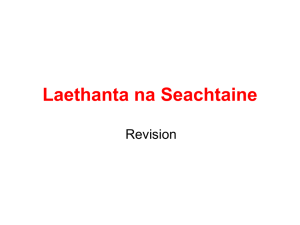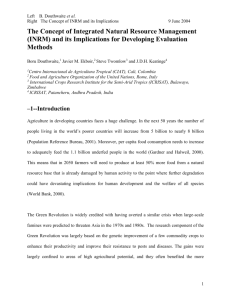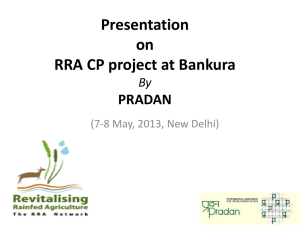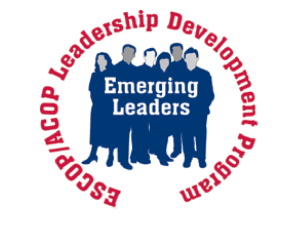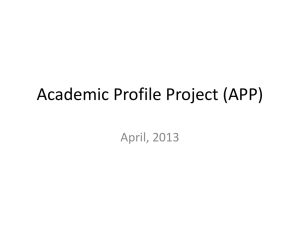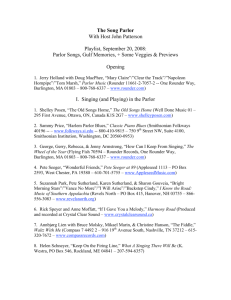Inter-sectoral policy coordination in the natural resource sectors of
advertisement
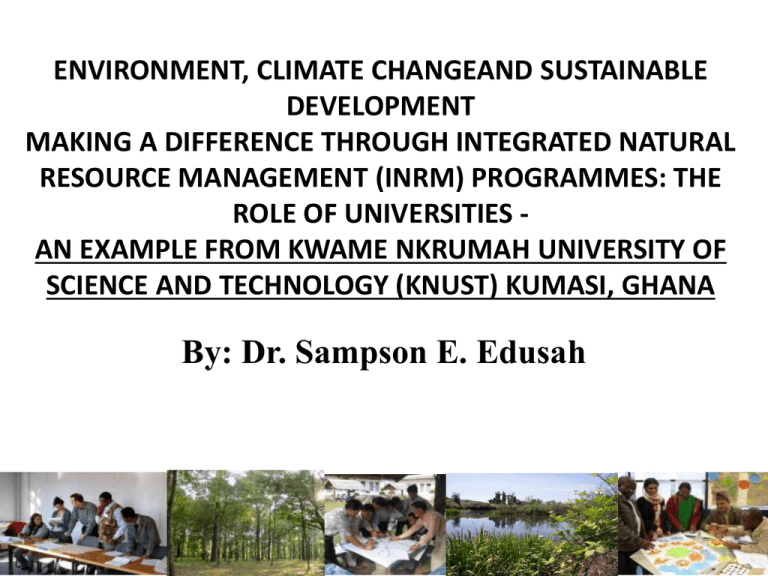
ENVIRONMENT, CLIMATE CHANGEAND SUSTAINABLE DEVELOPMENT MAKING A DIFFERENCE THROUGH INTEGRATED NATURAL RESOURCE MANAGEMENT (INRM) PROGRAMMES: THE ROLE OF UNIVERSITIES AN EXAMPLE FROM KWAME NKRUMAH UNIVERSITY OF SCIENCE AND TECHNOLOGY (KNUST) KUMASI, GHANA By: Dr. Sampson E. Edusah Introduction • The paper looks at the implementation of the Integrated Natural Resource Management (INRM) project at the College of Agriculture and Natural Resources (CANR), KNUST initiated in 2005. • Four Dutch Consortium Institutions led by Tropenbos International are offering technical support to CANR. • The three other members of the consortium are the Centre for Development Innovation (CDI) WUR, the International Centre of oriental Research for Agriculture (ICRA) and DHO formerly of the University of Amsterdam. [2] • CANR recognises that environment, climate change and sustainable development are issues that have engaged the attention of the world for some time now due to their combined effect on the existence of human race. • Many people who live in rural areas across the globe, particularly in Sub-Saharan Africa, and are largely poor are dependent on natural resources for most of their daily requirements. They own their very existence and survival to natural resource. • It has been recognised that natural resource management (NRM) is complex and multi-faceted –having policy, institutional, social, economic and technical dimensions. [3] • NRM needs to deal with these issues and circumstances as they arise. • Within NRM there can be many different reactions to dynamic change: i. existing management practices and technologies, policies and institutional arrangements may no longer be sufficient; ii. power relations, benefit distribution, and interests may no longer be in balance; iii. ecological functions may be disrupted; iv. risks may exceed management capacity; v. economic forces may outstrip conservation forces; and vi. sanctions and cultural heritage associated with management practices as well as ownership patterns, may no longer be operating. Paradigm Shift • Consequently a paradigm shift is call for, a shift from business as usual, and a shift from lineal approach to interdisciplinary approach. • The paradigm shift needs to start with institutions of higher learning. • These Institutions, particularly the universities, are well placed to make the necessary curriculum changes that will turn out future professionals that have the skills and knowledge to work in interdisciplinary teams. • Interdisciplinary approach to problem solving means that professionals of different backgrounds work together to solve a complex problem. [2] • It was to respond to this paradigm shift and to address the growing concern of the problems of natural resource use that the CANR at KNUST initiated the Integrated Natural Resource Management (INRM) project in Ghana. • The project is entitled "Institutionalization of Integrated Natural Resource Management (INRM) principles and approaches in the strategy and academic programmes of the College of Agriculture and Natural Resources (CANR) of Kwame Nkrumah University of Science and Technology (KNUST)" Objectives of the INRM Project The overall objective of the project is to enhance the capacity of CANR to offer programmes based on the approaches and principles of INRM to strengthen the INRM capabilities among environment related institutions and organizations to contribute to environmental management and sustainable development in Ghana. The rationale for introducing INRM at CANR The rationale for introducing INRM at the University is to respond to the need to train higher calibre manpower that would respond to the rapid environment, climate change and sustainable development changing situation of Ghana. Definition of INRM • INRM is defined as an approach that integrates research on different types of natural resources into stakeholder-driven processes of adaptive management and innovation to improve livelihoods, agro-ecosystem resilience, agricultural productivity and environmental services at community, ecoregional and global scales of intervention and impact’ (Hawkins et al 2009) . • Also Sayer and Campbell (2004) defines INMR as a systems approach and a process-orientated approach that leads to measurable impacts and outcomes; work at multiple scales with multiple stakeholders; address issues of tradeoffs; employ new tools and methods; be amenable to scaling up and out; ....” [2] • CGIAR/ICARDA (2005) defines INRM as “an approach to research that aims at improving livelihoods, agroecosystem resilience, agricultural productivity and environmental services. In other words, it aims to augment social, physical, human, natural and financial capital. • The CANR adopted a working definition of INRM as a holistic and collective approach to resolving complex environmental problems INRM Efficiency The efficiency of INRM in dealing with these problems comes from its ability to: i. empower relevant stakeholders ii. resolve conflicting interests of stakeholders iii. foster adaptive management capacity iv. focus on key causal elements (and thereby deal with complexity) v. integrate levels of analysis vi. merge disciplinary perspectives vii. make use of a wide range of available technologies viii. guide research on component technologies ix. generate policy, technological and institutional alternatives Principles of INRM • . The ‘defining principles’ of INRM as being used by CANR are similar to those of IAR4D and as applied by other institutions such as ICRA and Royal Tropical Institute. These are: • INRM integrates the perspectives, knowledge and actions of different stakeholders around a common theme. The theme or ‘entry point’ represents a research and development ‘challenge’, identified by one or more stakeholders who recognize that a broader working alliance is needed to achieve the desired development impact. • INRM integrates the learning that stakeholders achieve through working together. Beyond simply a concerted action process, INRM is a social learning process, with stakeholders learning from the experience of working together. • INRM integrates analysis, action and change across the different (environmental, social and economic) ‘dimensions’ of development. The general and current concepts of ‘sustainable development’ and ‘multi-functional agriculture’ emphasise the interlinked ‘dimensions’ of such development. • INRM integrates analysis, action and change at different levels of spatial, economic and social organization. How different is INRM • The learning process of INRM are alternative generic training programmes and a new way of impacting knowledge to students particularly at the graduate level by organizing learning around interdisciplinary teams. • Interdisciplinary approach relies on the strength of team members to train present and future professionals to be able to solve complex INRM problems. • INRM approach is markedly different from the lineal or conventional approach to teaching and learning because it relies on the strength of teamwork, institutional collaboration and stakeholder engagement. • Figure 1 illustrates the contrasting learning approaches. Lecture Methods (by Faculty) Innovation is a complex, multifaceted process Integrating knowledge from multiple sources Institutional Charge Balanced partnership of multiple stakeholders Transfer of Knowledge (Students Acquire skills) Employment Interdisciplinary and inter-institutional teams INRM Stakeholders have different perspectives, interest and power New Professional Roles and Capabilities (Employment) Joint ownership of the process Negotiate compromises Clearly defined between interest of different responsibilities of stakeholders stakeholders Approach to INRM institutionalisation at CANR • Embedding INRM principles in academic programmes and strategy of the College required pragmatic steps to be taken: 1. Institutional Arrangement for project implementation It was realised from the onset of the project that some statutory bodies of the College such as the Academic Board could slow down the implementation of the project. Consequently, a Project Implementation Committee (PIC) was put in place to facilitate the execution of the project. 2. Capacity development Considerable effort and resources were committed to build the capacity of academic staff of the College. This is because it became clear at the start of the project that the staff of the College lacked sufficient skills and knowledge in INRM principles. [2] 3. Stakeholder Engagement The INRM principles stress strong stakeholder engagement at all levels and this challenge was taken up by the College. Several stakeholders in the natural resource management in both governmental and non-governmental institutions and organisations are actively engaged. 4. Team work There was the need to form effective cross-disciplinary learning teams that are able to work effectively across disciplines with good team management Constraints to institutionalisation of INRM • that awareness of INRM principles and the rationale of embedding them in the College is low amongst staff • Staff remain largely individualistic – staff are primarily concerned with themselves – a culture of ‘what I can get’ rather than ‘what I can contribute to the University’; • resistant to new ideas; and de-motivated. • The academic staff involved in the project maintain their full teaching loads at various departments of the College. This is of great disincentive to them and as a result they tend to adopt lukewarm attitude to some activities of the project • • • • [2] The large number of staff members, institutions and stakeholders involved in the project makes coordination difficult. It takes considerable time to get some activities done. The designing of the MSc programmes for instance suffered considerable delays due to the extensive engagement of stakeholders and institutions. The university bureaucracy and requirements tend to slow down some activities of the project. Implementing INRM principles by CANR Education External stakeholders engaged in curricula development / design and teaching Room for experiential learning by doing (rather than being taught) Focusing on problem solving capacities (rather than on just acquiring knowledge) Room to apply real world issues in a professional context (rather than on classroom case studies or artificial/ academic field work situations) Room for inter-disciplinary curriculum development and teaching within and between faculties Collective learning (rather than individual) Research Joint research with stakeholders Room for inter-disciplinary research within and between faculties Problem-oriented research coidentified/co-researched and (partly) paid for by external stakeholders Research more linked to policy processes with long-term strategic engagement Link research to teaching around real life cases More consistency and complementarities in research programmes Experimentation with other research models such as action research Service to the community Clear strategic orientation on intended impact and service delivery (whose problem will be solved?) Consistency in programme to translate new knowledge (research result) in societal impact Long-term R&D assignments in support of change processes in society Quality checks in place by engagement of independent bodies Way Forward The following suggestions have been put forward to help accelerate the process of institutionalisation of the INRM at CANR. 1. Working together: • Ownership of INRM principles should firmly shift from project context to the leadership of CANR with the Change Coordinating Committee leading the process. • Organise and invest in (long-term, mutually beneficial) partnerships, platforms, networks around research and development themes. • Proactively and in a business-oriented manner engage stakeholders in jointly designing, implementing, documenting and reviewing research activities, educational programmes and outreach. • Push the boundaries with the University especially in relation to HRM systems and procedures. This is necessary to embed a new way of working into the work culture of CANR. Reward/ remuneration policies need to be developed and implemented, revised responsibilities need to be clearly outlined and captured in job descriptions. • [2] 2. Learning together: • The need to recognise the importance of communication in a change process and develop a communication strategy which views all communication strategically and which uses advanced techniques to communicate CANR’s vision and mission to relevant internal and external stakeholders • Recognise the link between learning and change. Learning should be at the heart of the performance review and M &E systems as well as opportunities of learning built into the working week. • Make time and space available for staff to reflect on and exchange experience, both formally (learning oriented M&E, publications and seminars) and through informal mechanisms. • Design incentive structures and working processes that encourage working, experimenting and learning in teams and partnerships. • Document and capitalise on learning; encourage documentation of lessons learnt and have knowledge sharing and management procedures in place. [3] 3. Changing together: • CANR should develop and test a Theory of Change – currently the college is engaged in a major change process without having developed such a theory. The present theory centres on awareness raising/engaging stakeholders. A detailed theory based upon systems thinking - needs to be developed and tested along with a theory of implementation which identifies priorities surrounding how the change process would be rolled out through the College. • An important step would be for CANR to update its Strategic Plan ensuring that INRM principles are firmly embedded within it. This will entail revisiting CANR’s vision, mission, goals, strategic objectives as well as any associated budgets and budget lines. Strengthening INRM capacities At individual staff level (competencies) At CANR/KNUST organizational level (norms & culture) At institutional level (conditions & mechanisms for inter-institutional linkages) At individual staff level (competencies) Apart from knowledge in the individual academic discipline also in meta-disciplines: systems thinking, knowledge management, strategic planning, knowing how to learn, effective writing, use of ICT, etc.; In social skills: communication, teamwork, networking, facilitation, etc., In mindsets and attitudes: empathy, self-awareness, self-regulation, selfmotivation, social awareness At CANR/KNUST organizational level (norms & culture) In structures and processes needed to provide performance and incentives that encourage interdisciplinary teamwork In partnerships with other stakeholders With emphasis on mutual learning Improved communication With effective knowledge management that promotes learning and change At institutional level (conditions & mechanisms for inter-institutional linkages) That allow different stakeholders individuals and organisations, from public and private sectors – to come together on a “level playing field” Finding appropriates ways to manage & finance inter-institutional space Linking education and research to policy development, remaining relevant and problem-oriented. Contribution of the INRM project The project is making considerable contribution to climate change, environment and sustainable development through the development of new and innovative graduate and re-tooling programmes. 1. Masters programmes: • MSc in Governance in natural resource management; • MSc in Development innovation. 2. Short Course in: • Adaptive management in natural resources • Governance in natural resources management • Value Chain Governance in natural resources Conclusion • The College of Agriculture and Natural Resources has come a long way in the implementation of the INRM project. • The adaptation of the concept of INRM by CARN is in line with current thinking and development in environment climate change and sustainable development. • CARN recognises that issues related to natural resources management are complex and encompasses different disciplines. • CANR recognises that the conventional approach to teaching and learning has outlived its usefulness. Furthermore, stakeholders particularly, employers of the products of the KNUST are asking for graduates with the ability and skills to function as team members. • INRM approach to teaching and learning offers the alternative and the platform for teaching and learning that will turnout professionals to deal with INRM issues in a holistic manner to contribute to environmental climate change and sustainable management challenges facing Ghana.
